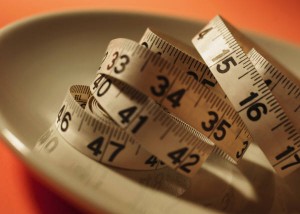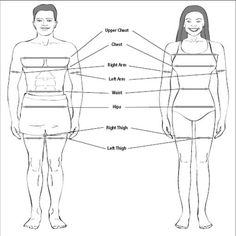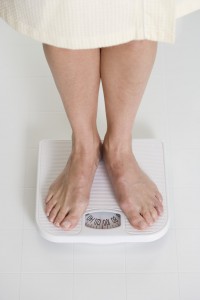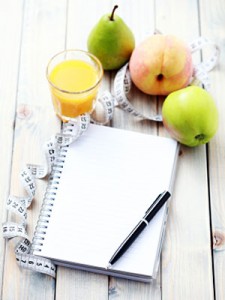Welcome to week one of the Six Weeks to a Healthy Diet course.
This first week will get you started by teaching you how to assess your current weight and calorie requirements and learn how to keep track of the foods you should eat (and the ones you shouldn’t have eaten).
Once you have studied this week’s lesson, you are ready to take the quiz before moving on to week two.
Week 1 – Starting with the Stats
Don’t worry, no college-level statistics class here. Your first lesson is about assessing your current weight and learning how to keep track of the foods you should eat .
Understanding weight and calorie needs are important for good health and disease prevention, but remember that this course is not about “being on a diet.” It is about making dietary changes that will help keep you healthy, youthful and looking great throughout your whole life. Chances are that if your diet is unhealthy, your weight isn’t what you want it to be.
If you’re overweight, you need to take a few measurements before changing your diet so that you can keep track of your progress over the next six weeks. If you are happy with your weight, but you know your diet is bad, you don’t need to worry too much about numbers on the scale, but you will need to get into the habit of tracking the foods you eat for a while.
Setting Goals and Tracking Your Progress
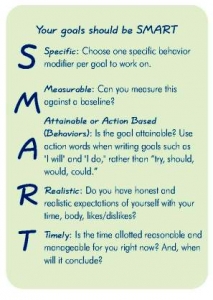 I can’t stress this enough. You will have more success with your dietary changes if you have a little something to measure and track as you go along. You should also set a few goals along the way to keep yourself motivated.
I can’t stress this enough. You will have more success with your dietary changes if you have a little something to measure and track as you go along. You should also set a few goals along the way to keep yourself motivated.
Most people decide to measure their weight and body mass index and set goals to lose weight. Health-related goals could also include changing your body fat percentage, lowering high cholesterol levels, decreasing high blood pressure or improving blood sugar control.
If weight change or a lower number on a lab test is your goal, you need to think about it realistically. You didn’t gain all of those pounds overnight, so don’t plan on losing more than a pound or two each week. Actually, choosing a magic number such as “I am going to lose 25 pounds” or “I am going to get my cholesterol down to 190” aren’t really useful goals. You may want to lose 25 pounds, or need to lower your cholesterol, but your goals should be actions, not wishes.
For example, think of those 25 pounds as a target, instead. Pick a goal that allows you to take action, like “I will stay within my daily calorie target at least three times this week,” or “I will take my lunch to work three times this week instead of eating fast food.” Keep these goals realistic. Vowing to stay under your daily calorie target every single day for a year is an unrealistic goal. Take it a week at a time, or even one day at a time.
Taking Your Baseline Measurements
Why is your weight and body composition important? Being overweight or obese is associated with a greater risk of cardiovascular disease, diabetes and certain cancers. In addition, when you eat healthy foods and your body is at the right weight, you feel better and have more energy.
You will start changing your diet with the next lesson, but first, take some time to assess your body. You can choose one or more body composition measurements. Your weight, body mass index, waist circumference and body fat percentage are all good methods to help you determine how close you are to a healthy weight.
You will also need to know your weight and height to determine how many calories you need. Whether you need to lose, or maintain your weight, you need the right number of calories each day.
Your weight is an important measurement in your overall health. In fact, every doctor’s visit begins with a step on the scale to see how much you weigh. You can weigh yourself at home too, or at the gym or health club. All you need is an inexpensive scale. If you decide to use weight changes as your goal, be sure to use the same scale each time you weight yourself because there can be a pound or two difference between any two scales. As long as you use the same scale, you can be sure that the changes in your weight are accurate.
Weighing yourself the first time is easy. Just get naked (if you are at home), step on the scale and record your weight. Subsequent weigh-ins aren’t difficult either, but you might want to weigh yourself at the same time of day since your body weight naturally fluctuates a little bit. If you weigh yourself at the gym or doctor’s office, choose clothing that is similar in weight each time.
You really should only weigh yourself about once every week. Don’t hop on the scale every day. It takes time to make long-lasting changes and you can drive yourself crazy with worry when the numbers on the scale don’t change as quickly as you want. Remember the discussion on choosing goals? Another reason choosing weight change as a goal isn’t so good is because your weight will naturally fluctuate every day.
As you meet your action goals each week, the number on the scale will go the direction you want it to. But don’t just depend on weight; you can also measure your body mass index, waist circumference (both of which are important clues for your health) or you can grab a measuring tape and monitor changes in your dress size. And, of course, in a few weeks, you will feel a difference in how your clothes fit.
Calculating Your Body Mass Index
Your body mass index, or BMI, is an estimation of your body fat based on your weight and height. For most of us, it works just fine, but it does have limitations. The BMI may overestimate the amount of fat in people who are very muscular and it may underestimate the amount of fat in elderly people who have lost muscle mass. The formula for estimating your BMI is your weight in pounds/height in inches squared x 703. You can use the BMI calculator to do the math for you.
Understanding Your BMI
Your BMI is used to determine if you are overweight, obese, at a healthy weight, or underweight: Underweight = less than 18.5 Normal weight = 18.5-24.9 Overweight = 25-29.9 Obesity = BMI of 30 or greater
Having a BMI or 25 or more may put you at an increased risk for cardiovascular disease, diabetes and some forms of cancer.
This measurement only requires an inexpensive cloth measuring tape. Place the measuring tape around the largest part of your belly. Men who have a waist larger than 40 inches (102 cm) and women with a waist larger than 35 inches (88 cm) have a greater risk of chronic disease.
As your BMI rises above 25 and your waist grows, your risk for chronic disease increases too. You need to cut your calories, exercise and work hard on choosing healthier foods.
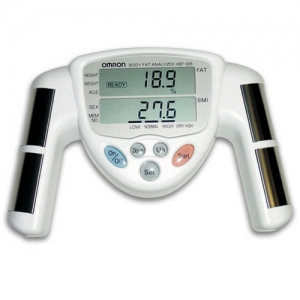 Getting High – Tech: Body Fat Percentage
Getting High – Tech: Body Fat Percentage
You can measure the amount of fat you have stored in your body easily with a body composition scale. This type of scale sends a small electrical signal through your body that will give you an estimate of how much of your body is lean body mass (muscles, bones and such) and body fat. Men should aim for 15 to 18% body fat and a healthy range for women is 20 to 25%.
Tracking Your Progress
Now that you have a few numbers to work with, write them down and re-assess your weight, BMI, waist circumference, dress size or fat percentage periodically. How often? No more than one time each week. Your body will change for the better as you clean up your diet, however those changes will occur slowly. Weighing yourself every day may just frustrate you if you expect the numbers to change dramatically over night.
Keeping a Food Diary
Studies show that keeping a food diary helps weight loss efforts and I think it will also help you keep track of healthy food choices. Maybe keeping a food diary doesn’t sound like much fun, but it isn’t difficult to do and really helps to keep you on track. Even if your weight isn’t an issue, you will have more success with your dietary transformation if you keep track of what you eat.
A food diary can be very simple or complex. All you really need is a small notebook to jot down all of the foods you eat. Then you can calculate the totals for whatever you are tracking, which can be calories, or servings of food from each of the food groups, fiber, carbs or fat grams. If your goal is to eat four servings of vegetables every day, or cut back those three daily sugary treats to just one, you will know if you met your goal at the end of the day.
If you’re counting calories, fat grams, carbs or fiber, then you will need to do a little more work. You need to keep track of everything you eat and drink, accurately on your food diary pages. If you have a difficult time with understanding portion sizes, use a kitchen scale for a while.
Each night you will need to look up your calorie, carb, fat or fiber totals. You can sometimes get the nutrition information, including calories, from the food labels on packaged foods. You can also determine the number of calories by looking at calorie tables or by using an online database such as the one at Calorie Count Plus.
Your Assignments This Week
Next week you will begin the steps of changing the types of foods you eat. This week I want you to pick one or more of the body composition measurements and set up your food diary.
Choose a goal this week that works for you.
Here is an example to get you started: I will write down everything I eat and drink in my food diary three or more days this week.
Next Lesson: Six Weeks to a Healthy Diet Week 2 Slash the Sugar
Lesson 1 – Starting with the Stats Quiz
Think you got it all down? Take the quiz to make sure you are ready to move on to lesson two.
1) It is important to weigh yourself every day.
a. True
b. False
2) Being overweight or obese may increase your risk of:
a. Cardiovascular disease
b. Some cancers
c. Diabetes
d. All of the above
3) A man’s risk of chronic disease increases when his waist measures more than 40 inches (102 cm).
a. True
b. False
4) Going on a fad diet is a great way to lose weight permanently.
a. True
b. False
5) Keeping a food diary will help you make healthy dietary changes.
a. True
b. False
6) Your Active Metabolic Rate:
a. Goes up as your level of physical activity goes down
b. Goes up as your level of physical activity goes up
c. MIs not affected by your level of physical activity
d. All of the above
7) Which BMI represents a healthy weight?
a. 15
b. 20
c. 39
d. 52
8)You should set high, difficult-to-achieve goals to stay motivated.
a. True
b. False
9) This rate represents the number of calories you need just to be awake and alive:
a. Active Metabolic Rate
b. Body Mass Index
c. Basal Metabolic Rate
d. None of the above
10) Having a higher body mass index means a lower risk of chronic disease.
a. True
b. False
Starting With the Stats Quiz Answers
Six Weeks to a Healthy Diet – Week 1
1) It is important to weigh yourself every day. The correct answer is “b” False.
2) Being overweight or obese may increase your risk of: The correct answer is “d” All of the above.
3) A man’s risk of chronic disease increases when his waist measures more than 40 inches (102 cm). The correct answer is “a” True.
4) Going on a fad diet is a great way to lose weight permanently. The correct answer is “b”False .
5) Keeping a food diary will help you make healthy dietary changes. The correct answer is “a” True.
6) Your Active Metabolic Rate: The correct answer is “b” Goes up as your level of physical activity goes up.
7) Which BMI represents a healthy weight? The correct answer is “b” 20.
8) You should set high, difficult-to-achieve goals to stay motivated. The correct answer is “b” False.
9) This rate represents the number of calories you need just to be awake and alive: The correct answer is “c” Basal Metabolic Rate.
10) Having a higher body mass index means a lower risk of chronic disease. The correct answer is “b” False.


